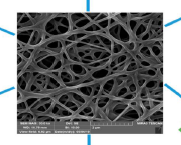Electrochemical Glucose Biosensors, Recent Advances, Advanced Nanosystems and Evolution of Biosensor Platforms
Keywords:
Glucose Biosensors, Nanosystems, Recent Advances, Biosensor PlatformsAbstract
Since the advent of sophisticated nanostructures and nano-composites, a plethora of sensing platforms have been developed through rigorous investigation into different immobilisation techniques and the enhancement of electron transfer efficiency between the enzyme and the electrode. Several nanomaterials and composites have found use in biosensors, such as carbon nanotubes, gold nanoparticles, chitosan hydrogel composites, and carbon/graphene quantum dots, which have enhanced the immobilisation process or demonstrated electrocatalytic activity towards glucose. Since traditional glucose meters use human blood or serum as their sample medium, they necessitate intrusive sampling procedures. Researchers have shifted their attention to non-invasive sensing platforms that may detect glucose from various physiological fluids such as saliva, perspiration, or tears, in an effort to alleviate the pain and discomfort associated with these invasive approaches. These innovative developments in miniaturised technologies for painless, non-invasive glucose testing have the potential to revolutionise diabetes control and management. Also, other potential target analytes could have their point-of-care devices developed as a result of these accomplishments. One of the best examples of a device that can be used at the point of care is the personal glucose meter. Because of its portability, user-friendliness, quantitative results, and accuracy, commercially accessible glucose meters have seen extensive application. Whole blood glucose detection is accomplished using these instruments. But the brilliant thought of reusing the PGMs opens the door to developing sensing platforms for non-glucose targets to use as POC devices. A plethora of new techniques for detecting bacteria, DNA, illness biomarkers, and other substances in the presence of the invertase enzyme have been created using personal glucose meters. Research on the limitations of portable glucose meters, such as their small linear range and the impact of naturally existing glucose in biological samples, is necessary before these devices may find widespread use. There are, of course, a plethora of additional untested approaches as well. Therefore, for the early-stage identification of biomarkers linked to a variety of malignancies and diseases (e.g., Alzheimer's, multiple sclerosis, etc.), there is a strong need for inexpensive sensing devices that are durable, accurate, sensitive, selective, and reasonably priced. It is worth mentioning that another significant difficulty in the field of diabetes control is the creation of sensors that can reliably, continuously, and quickly monitor glucose levels in real-time while maintaining high selectivity. These days, electrochemical biosensors are all the rage due to their selectivity, sensitivity, ease of use, and speed of response.
Downloads
References
Riklin, A.; Katz, E.; Wiliner, I.; Tocker, A.; Bückmann, A.F. Direct Electrical Communication between Graphite-Electrodes and Surface Adsorbed Glucose-Oxidase Redox Polymer Complexes. Angew. Chem. Int. Ed. Engl. 1990, 29, 82–89.
Degani, Y.; Heller, A. Direct Electrical Communication between Chemically Modified Enzymes and Metal-Electrodes. I. Electron-Transfer from Glucose-Oxidase to Metal-Electrodes Via Electron Relays, Bound Covalently to the Enzyme. J. Phys. Chem. 1987, 91, 1285–1289.
Rizwan, M.; Elma, S.; Lim, S.A.; Ahmed, M.U. AuNPs/CNOs/SWCNTs/chitosan-nanocomposite modified electrochemical sensor for the label-free detection of carcinoembryonic antigen. Biosens. Bioelectron. 2018, 107, 211–217. [CrossRef]
Lin, Y.; Lu, F.; Tu, Y.; Ren, Z. Glucose Biosensors Based on Carbon Nanotube Nanoelectrode Ensembles. Nano Lett. 2004, 4, 191–195.
Xu, S.; Zhang, Y.; Zhu, Y.; Wu, J.; Li, K.; Lin, G.; Li, X.; Liu, R.; Liu, X.; Wong, C.-P. Facile one-step fabrication of glucose oxidase loaded polymeric nanoparticles decorating MWCNTs for constructing glucose biosensing platform: Structure matters. Biosens. Bioelectron. 2019, 135, 153–159.
Yu, Y.; Chen, Z.; He, S.; Zhang, B.; Li, X.; Yao, M. Direct electron transfer of glucose oxidase and biosensing for glucose based on PDDA-capped gold nanoparticle modified graphene/multi-walled carbon nanotubes electrode. Biosens. Bioelectron. 2014, 52, 147–152.
Juska, V.B.; Pemble, M.E. A dual-enzyme, micro-band array biosensor based on the electrodeposition of carbon nanotubes embedded in chitosan and nanostructured Au-foams on microfabricated gold band electrodes. Analyst 2020, 145, 402–414.
Feng, X.; Cheng, H.; Pan, Y.; Zheng, H. Development of glucose biosensors based on nanostructured graphene-conducting polyaniline composite. Biosens. Bioelectron. 2015, 70, 411–417.
Baek, S.H.; Roh, J.; Park, C.Y.; Kim, M.W.; Shi, R.; Kailasa, S.K.; Park, T.J. Cu-nanoflower decorated gold nanoparticles-graphene oxide nanofiber as electrochemical biosensor for glucose detection. Mater. Sci. Eng. C 2020, 107, 110273.
R. O. Potts, J. A. Tamada and M. J. Tierney, Glucose monitoring by reverse iontophoresis, Diabetes/Metab. Res. Rev., 2002, 18, S49–S53.
J. T. Baca, D. N. Finegold and S. A. Asher, Tear glucose analysis for the noninvasive detection and monitoring of diabetes mellitus, Ocul. Surf., 2007, 5, 280–293.
Q. Yan, B. Peng, G. Su, B. E. Cohan, T. C. Major and M. E. Meyerhoff, Measurement of tear glucose levels with amperometric glucose biosensor/capillary tube configuration, Anal. Chem., 2011, 83, 8341–8346.
B. Beden, F. Largeaud, K. B. Kokoh and C. Lamy, Fourier transform infrared reflectance spectroscopic investigation of the electrocatalytic oxidation of D-glucose: Identification of reactive intermediates and reaction products, Electrochim. Acta, 1996, 41, 701–709.
M. W. Hsiao, R. R. Adzic and E. B. Yeager, The dissipated energy of electrode surfaces: Temperature jumps from coupled transport processes, J. Electrochem. Soc., 1996, 143, 759–767.
Y. Xia, W. Huang, J. F. Zheng, Z. J. Niu and Z. L. Li, Nonenzymatic amperometric response of glucose on a nanoporous gold film electrode fabricated by a rapid and simple electrochemical method, Biosens. Bioelectron., 2011, 26, 3555–3561.
H. Gao, F. Xiao, C. B. Ching and H. Duan, One-step electrochemical synthesis of PtNi nanoparticle-graphene nanocomposites for nonenzymatic amperometric glucose detection, ACS Appl. Mater. Interfaces, 2011, 3, 3049–3057.
Y. Y. Song, D. Zhang, W. Gao and X. H. Xia, Nonenzymatic glucose detection by using a three-dimensionally ordered, macroporous platinum template, Chem.–Eur. J., 2005, 11, 2177–2182.
S. Park, H. Boo and T. D. Chung, Electrochemical nonenzymatic glucose sensors, Anal. Chim. Acta, 2006, 556, 46–57.
K. E. Toghill and R. G. Compton, Electrochemical nonenzymatic glucose sensors: A perspective and an evaluation, Int. J. Electrochem. Sci., 2010, 5, 1246–1301.
M. S. Celej and G. Rivas, Amperometric glucose biosensor based on gold-dispersed carbon paste, Electroanalysis, 1998, 10, 771–775.
M. W. Hsiao, R. R. Adzic and E. B. Yeager, The effects of adsorbed anions on the oxidation of D-glucose on gold single crystal electrodes, Electrochim. Acta, 1992, 37, 357–363.
L. D. Burke, Premonolayer oxidation and its role in electrocatalysis, Electrochim. Acta, 1994, 39, 1841–1848.
X. M. Chen, Z. J. Lin, D. J. Chen, T. T. Jia, Z. M. Cai, X. R. Wang, X. Chen, G. N. Chen and M. Oyamad, Nonenzymatic amperometric sensing of glucose by using palladium nanoparticles supported on functional carbon nanotubes, Biosens. Bioelectron., 2010, 25, 1803–1808.
C. X. Wang, L. W. Yin, L. Y. Zhang and R. Gao, Ti/TiO2 nanotube array/Ni composite electrodes for nonenzymatic amperometric glucose sensing, J. Phys. Chem. C, 2010, 114, 4408–4413.
W. Wang, Z.Y. Li, W. Zheng, J. Yang, H. N. Zhang and C. Wang, Electrospunpalladium(IV)-doped copper oxide composite nanofibers for non-enzymatic glucose sensors, Electrochem. Commun., 2009, 11, 1811–1814.
H. Yin, C. Zhou, C. Xu, P. Liu, X. Xu and Y. Ding, Aerobic oxidation of D-glucose on support-free nanoporous gold, J. Phys. Chem. C, 2008, 112, 9673–9678.
X. Kang, Z. Mai, X. Zou, P. Cai and J. Mo, A sensitive nonenzymatic glucose sensor in alkaline media with a copper nanocluster/multiwall carbon nanotube-modified glassy carbon electrode, Anal. Biochem., 2007, 363, 143–150.
T. You, O. Niwa, Z. Chen, K. Hayashi, M. Tomita and S. Hirono, Anamperometric detector formed of highly dispersed Ni nanoparticles embedded in a graphite-like carbon film electrode for sugar determination, Anal. Chem., 2003, 75, 5191–5196.
H. Bai, M. Han, Y. Du, J. Bao and Z. Dai, Facile synthesis of porous tubular palladium nanostructures and their application in a nonenzymatic glucose sensor, Chem. Commun., 2010, 46, 1739–1741.
P. F. Luo and T. Kuwana, Nickel-titanium alloy electrode as a sensitive and stable LCEC detector for carbohydrates, Anal. Chem., 1994, 66, 2775–2782.
J. Zhao, F. Wang, J. J. Yu and S. S. Hua, Electro-oxidation of glucose at self-assembled monolayers incorporated by copper particles, Talanta, 2006, 70, 449–454.
J. H. Yuan, K. Wang and X. H. Xia, Highly ordered platinum-nanotubule arrays for amperometric glucose sensing, Adv. Funct. Mater., 2005, 15, 803–809
Luo, D.; Mu, T.; Sun, H. Sweet Potato (Ipomoea Batatas L.) Leaf Polyphenols Ameliorate Hyperglycemia in Type 2 Diabetes Mellitus Mice. Food Funct. 2021, 12, 4117–4131.
Perlmuter, L.C.; Flanagan, B.P.; Shah, P.H.; Singh, S.P. Glycemic Control and Hypoglycemia: Is the Loser the Winner? Diabetes Care 2008, 31, 2072–2076.
Wang, J.; Zhu, C.-K.; Yu, J.-Q.; Tan, R.; Yang, P.-L. Hypoglycemia and Mortality in Sepsis Patients: A Systematic Review and Meta-Analysis. Heart Lung 2021, 50, 933–940. [Google Scholar] [CrossRef]
Ortiz-Martinez, M.; Flores-DelaToba, R.; González-González, M.; Rito-Palomares, M. Current Challenges and Future Trends of Enzymatic Paper-Based Point-of-Care Testing for Diabetes Mellitus Type 2. Biosensors 2021, 11, 482.
Bellary, S.; Kyrou, I.; Brown, J.E.; Bailey, C.J. Type 2 Diabetes Mellitus in Older Adults: Clinical Considerations and Management. Nat. Rev. Endocrinol. 2021, 17, 534–548.
Von Scholten, B.J.; Kreiner, F.F.; Gough, S.C.L.; von Herrath, M. Current and Future Therapies for Type 1 Diabetes. Diabetologia 2021, 64, 1037–1048.
Teju, V.; Sowmya, K.V.; Yuvanika, C.; Saikumar, K.; Krishna, T.B.D.S. Detection of Diabetes Melittus, Kidney Disease with ML. In Proceedings of the 2021 3rd International Conference on Advances in Computing, Communication Control and Networking (ICAC3N), Greater Noida, India, 17–18 December 2021; pp. 217–222.
Abbas Abed Sharhan; Ahmed Obaid Hussain; Ameer Jawad Hadi and Ruqyajaaferbaqer,(2020). Histological Changes in Mice (Balb/c) Induced by Newcastle Virus in Digestive System. Indian J. Foren. Med. &Toxicol, Vol. 14, No. 1
Alaa Abd Alzahraa; Ahmed Obaid Hossain1; Abbas Abd Sherhan.(2020). The Effects of Newcastle virus Histologically Suspension on Some Organs of White Mice (Balb /c). Indian J. Foren. Med. &Toxicol., J. Vol. 14, No.
Faiza Jabar; Alaa Abdalzahraa; Ahmed Obaid Hossain,(2020). Histological Changes for Stachybotryschartarum Fungus in the Lungs and Nose for Infant White Mice . Ind. J. Health Res. & Dev. Vol. 11, No. 02
Haneen Imad Al-Sultani1* Ahmed Obaid Hussain1 and Hazar Shakir Saleh.(2023). Effect of Rosuvastatin on the liver in male albino rats. J. Edu. Pure Sci.- Univ. Thi-Qar Vol.13, No.3 .
Rabab J.H. Al-Hasseny, Ahmed Obaid Hossain, and Abbas K. Al-Mansoori.(2023). Characterization of Bioactive Chemical Compounds from Staphylococcus aureus and Evaluation of Antibacterial Activity. Int. J. Pharma. and Bio-Med. Sci. Vol 03 Iss. 11
Maha Diekan Abbas, Abbas K. Al-Mansoori, Zahraa Adnan Faraj, and Ahmed Obaid Hossain.(2023). Evaluation of Serological and Molecular Detection Methods for HBV and its Associated Risk Factors among General Population in the Province of Babil Iraq. Int. J. Pharma and Bio-Med. Sci.. Vol. 03 Iss. 06.
Al-Zubaidi SURA, Al-Ibadi ZEAD, Haneen Imad AL-SULTANI1, Ahmed OBAID and Hazar Shakir SALEH.(2024). THE EFFECTS OF ROSUVASTATIN EFFECT ON THE KIDNEY IN MALE ALBINO RATS. Int. J. App. Sci. Tech. Vol. 6, Iss. 1.
Rabab J.H. Al Hasseny, Abbas K. Al-Mansoori and Ahmed Obaid Hossain(2023). Bioactive Natural Compounds of Zingiber officinale Using Gas Chromatography-Mass Spectrometry and Evaluation of Its Antibacterial Activity. J. Cur. Med. Res. Opi. Vol. 06, Iss. 11.
Jwad, S.M.; AL-Fatlawi, H.Y. Types of Diabetes and Their Effect on the Immune System. J. Adv. Pharm. Pract. 2022, 4, 21–30.
Lin, M.-H.; Gupta, S.; Chang, C.; Lee, C.-Y.; Tai, N.-H. Carbon Nanotubes/Polyethylenimine/Glucose Oxidase as a Non-Invasive Electrochemical Biosensor Performs High Sensitivity for Detecting Glucose in Saliva. Microchem. J. 2022, 180, 107547.
Settu, K.; Chiu, P.-T.; Huang, Y.-M. Laser-Induced Graphene-Based Enzymatic Biosensor for Glucose Detection. Polymers 2021, 13, 2795.
Zare, Y.; Rhee, K.Y. Effects of Interphase Regions and Filler Networks on the Viscosity of PLA/PEO/Carbon Nanotubes Biosensor. Polym. Compos. 2019, 40, 4135–4141.
Zare, Y.; Rhee, K.Y.; Park, S.-J. Simple Model for Hydrolytic Degradation of Poly (Lactic Acid)/Poly (Ethylene Oxide)/Carbon Nanotubes Nanobiosensor in Neutral Phosphate-Buffered Saline Solution. J. Biomed. Mater. Res. Part A 2019, 107, 2706–2717.
Zare, Y.; Rhee, K.Y. Effect of Contact Resistance on the Electrical Conductivity of Polymer Graphene Nanocomposites to Optimize the Biosensors Detecting Breast Cancer Cells. Sci. Rep. 2022, 12, 5406.
Xu, L.; Zhu, Y.; Yang, X.; Li, C. Amperometric biosensor based on carbon nanotubes coated with polyaniline/dendrimer-encapsulated Pt nanoparticles for glucose detection. Mater. Sci. Eng. C 2009, 29, 1306–1310.
Yang, X.; Wang, Y.; Liu, Y.; Jiang, X. A sensitive hydrogen peroxide and glucose biosensor based on gold/silver core–shell nanorods. Electrochim. Acta 2013, 108, 39–44.
Yang, Z.; Tang, Y.; Li, J.; Zhang, Y.; Hu, X. Facile synthesis of tetragonal columnar-shaped TiO2 nanorods for the construction of sensitive electrochemical glucose biosensor. Biosens. Bioelectron. 2014, 54, 528–533.
Krishnan, S.K.; Prokhorov, E.; Bahena, D.; Esparza, R.; Meyyappan, M. Chitosan-Covered Pd@Pt Core–Shell Nanocubes for Direct Electron Transfer in Electrochemical Enzymatic Glucose Biosensor. ACS Omega 2017, 2, 1896–1904.
Lawal, A.T. Progress in utilisation of graphene for electrochemical biosensors. Biosens. Bioelectron. 2018, 106, 149–178.
Gupta, S.; Murthy, C.N.; Prabha, C.R. Recent advances in carbon nanotube based electrochemical biosensors. Int. J. Biol. Macromol. 2018, 108, 687–703.
Alim, S.; Vejayan, J.; Yusoff, M.M.; Kafi, A.K.M. Recent uses of carbon nanotubes & gold nanoparticles in electrochemistry with application in biosensing: A review. Biosens. Bioelectron. 2018, 121, 125–136.
Scognamiglio, V.; Arduini, F. The technology tree in the design of glucose biosensors. TrAC Trends Anal. Chem. 2019, 120, 115642.
Willner, B.; Katz, E.; Willner, I. Electrical contacting of redox proteins by nanotechnological means. Curr. Opin. Biotechnol. 2006, 17, 589–596.
Katz, E.; Willner, I. Integrated nanoparticle-biomolecule hybrid systems: Synthesis, properties, and applications. Angew. Chem. Int. Ed. 2004, 43, 6042–6108.

Downloads
Published
How to Cite
Issue
Section
License

This work is licensed under a Creative Commons Attribution 4.0 International License.
Current Clinical and Medical Education













